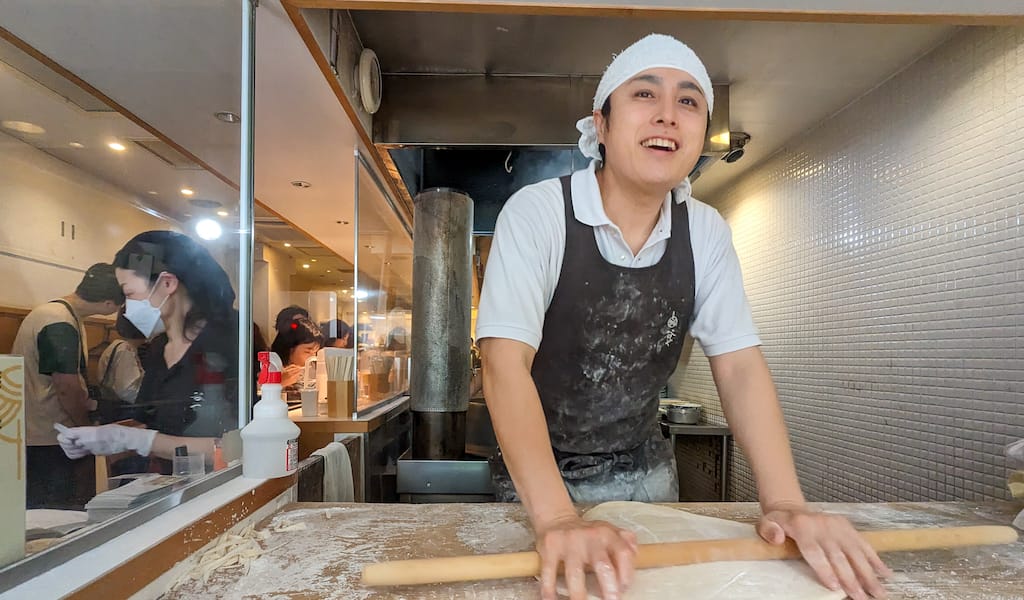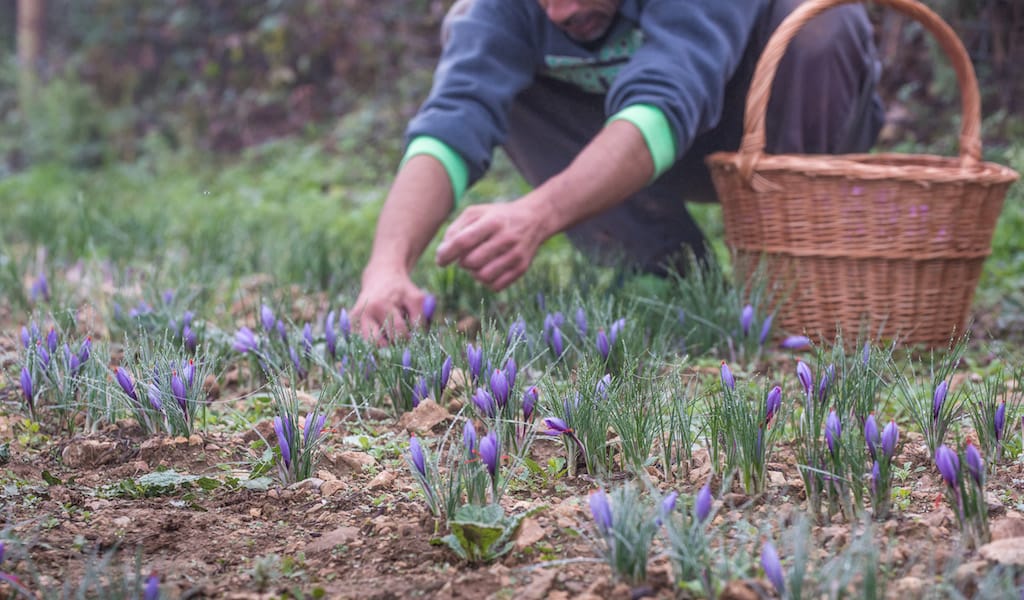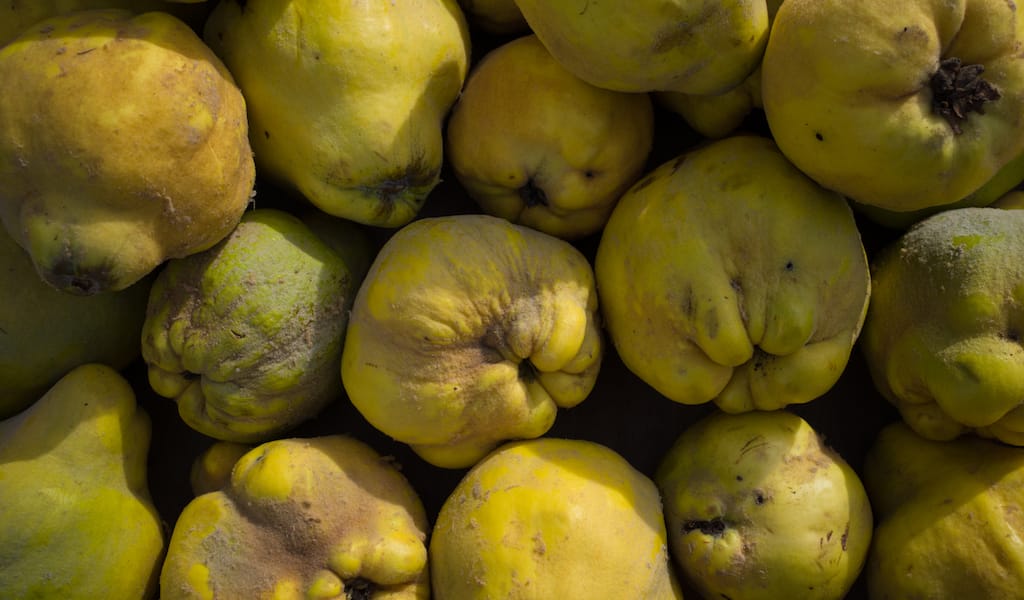Sometimes Tokyo feels like a simulacrum, a pixel-generated city restlessly tearing itself down and rebuilding itself in the latest image of a megacity. The Shibuya skyline morphed over the past decade, punctuated by mega malls. This year has brought the opening of Azabudai Hills, a mega complex that features offices, residences, and even an international school, the latest articulation of developer Mori Building’s vision to raise the “international competitiveness” of Tokyo.
Yet, for many, the city’s appeal lies not in the tower blocks of the wealthy, but at the microscale, in pockets of past decades, in the spaces where a miso shop might be wedged among apartments, where the best bar of the night might be ten stories up or two stories down, and where the evening hangout might only have five seats. There’s a delight in the haphazard urban fabric that can lead to unexpected encounters and unexpected eats. Here’s our tribute to our tastes of 2023.
Noodles: Udon Taniya
Udon are having a bit of a moment. It’s as if they have been seized upon by fatigued ramen-hunters craving a new noodle fix. It’s true that these fat, wheat-based noodles have great potential with their tantalizingly springy and chewy texture. Some might daringly describe them as pasta in disguise – I can hear Italians crying out in pain at this statement, but “udon carbonara” has been sneaking its way onto menus.
While several central udon restaurants are now on the international radar resulting in hour-long queues, Udon Taniya has somehow been overlooked, only drawing a lunchtime rush from Tokyoites in the know. This might be due to its location in Ningyocho, a truly charming and underrated part of Tokyo where Edo and Meiji-era businesses abound. Yet anyone walking past Udon Taniya will be sure to pause, if even for a moment. Owner Kazuyuki Tani bounces non-stop in the window, rolling out and cutting bundles of thick fresh udon, flicking the flour off them with enthusiasm and pride in equal measure.

Hailing from Kagawa, known as the “udon prefecture,” Tani honors the classics such as kitsune udon, udon in a warm rich broth topped with deep-fried tofu pouch, or niku udon, with thin strips of beef adding extra umami. There’s a whole menu of curry udon or cold dipping udon with various toppings, including freshly fried tempura. But the show-stealer is the mentai kamatama butter udon – a bowl of warm, chewy thick udon, curled beautifully in a bowl, topped with a spoonful of mentaiko (spicy pollack roe), one egg yolk and a generous amount of butter. Mixing it together becomes like a Japanese carbonara – it’s sensationally creamy and rich with a light kick, coating the chewy noodles and culminating in a tasty and textural perfection.
Pizza: Pizza Marumo
Japan has built a strong pizza reputation internationally, with pizza pilgrims considering Tokyo a major destination. A Tokyo-style pizza even made our best bites list in Istanbul this year. It’s something I’m endlessly asked about on tours, and invariably, I send guests to Pizza Marumo.
Pizza Marumo has made a name for itself phenomenally fast. Owner Yuki Motokura only launched his solo venture in December 2022 but is already winning international accolades – he was voted in as a top 10 pizza chef in the Best Chef Awards 2023. Dedicated to the dough, Motokura logs humidity and temperature daily as he aims for the perfect pizza base, which he cooks in his custom-made pizza oven. He honors pizza’s heritage, producing high quality margheritas and marinaras, including a half-and-half option for the conflict-torn among us. These are served alongside takes on other classics, such as Bismarck 2.0, which comes with not one but two eggs. To appreciate his genius, however, work through the specials with unique flavors. Japanese Pepper Bomb is a marinara with pine nuts, sweet confit tomatoes, sprinkles of chirimen-jako (dried small sardines) accentuated by mitsuna, a Japanese herb and kuroshichimi, a Japanese spice mix. Or PJ, which is coated in clam cream sauce with added clams, accented with smoked mozzarella, confit tomatoes and lemon. For a wildly Japanese take (and a surprise hit, even among the skeptical), the mayo-based Teriyaki Boys wins hearts with a dashi and teriyaki sauce, chicken salsiccia, mozzarella and corn. You can read our full review of Marumo here.
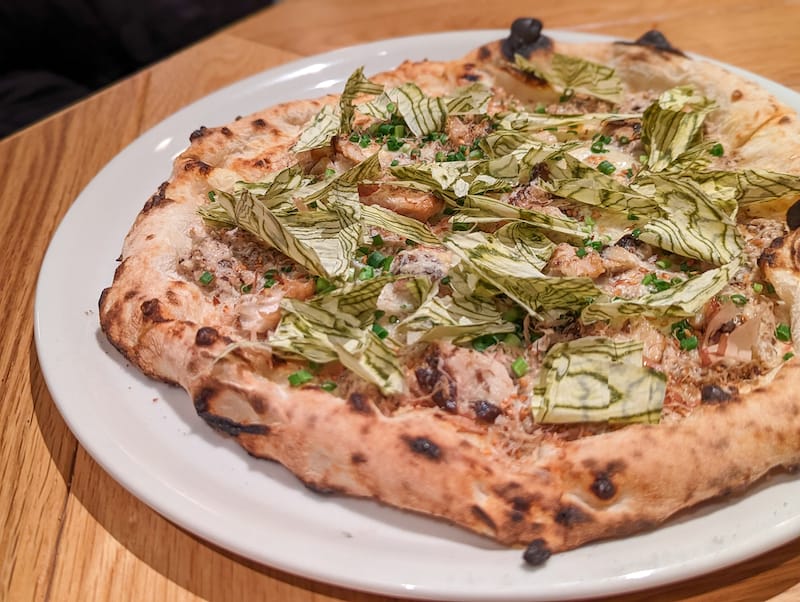
Izakaya: Shokkan Shibuya
Shokkan Shibuya has been topping lists for a while, and for good reason. Since its opening in 2007, it has steadily built a reputation as one of the best high-end izakayas in the area. Tucked in the basement of a relatively unremarkable building, it’s a sophisticated escape from the concrete, tarmacked world above. The cooking elevates izakaya classic dishes and gives them a fresh, creative twist. Begin the evening supping on a sake mimosa and snacking on crisp, colorful vegetables begging to be liberally dipped into a rich tomato miso. Follow up with a fresh sashimi platter that arrives like modern art. Then, perhaps work through rich savory-sweet braised beef and aubergine topped with a generous dollop of mustard. Round off with a claypot rice – the classic “paella” remains a popular choice, laden with generous amounts of seafood, and specials rotate through the seasons. Izakaya aren’t known for desserts, but Shokkan Shibuya delivers. On our last visit, we devoured an autumn kabocha Mont Blanc served on top of a monaka (wafer), a dish that manages to fuse two popular Japanese sweet treats into something worthy of its own category.
Shibuya Shokkan is at a price point above the average izakaya — expect to pay upwards of 10,000 JPY — but the quality and atmosphere leave no complaints. Make sure to reserve in advance and request counter seats.
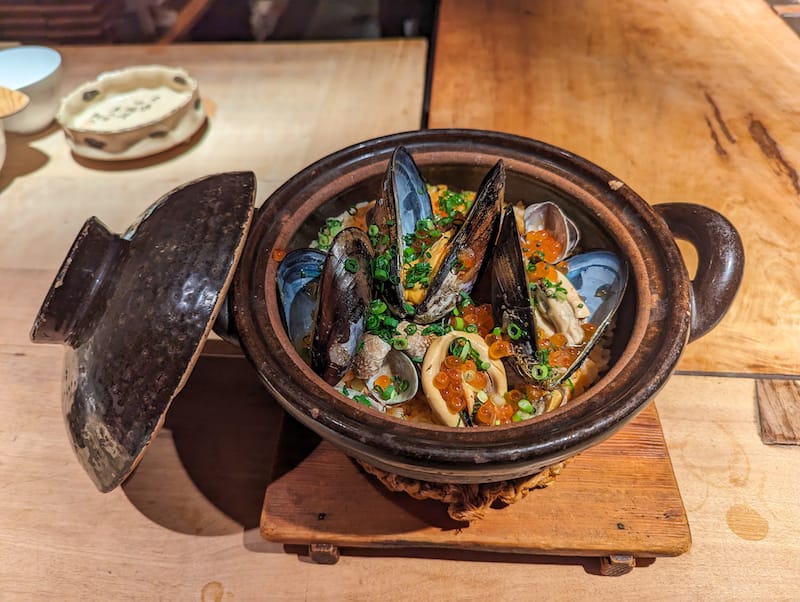
Yakiniku: Yakinikuen Azabujuban
An affordable dining haven in the upscale Azabujuban district, Yakinikuen offers plenty of atmosphere and incredibly delicious grilled meat, all in a surprisingly spacious (and fortunately well-ventilated) basement.
Japanese barbecue takes heavy inspiration from the Korean version. A meal is best started with an excellent kimchi selection and namul, assorted Korean vegetables. These are refreshing, tangy and spicy, provoking the palate and also making a courteous nod towards one’s daily vegetable intake, before the carnivorous marathon. Diners order plates of different cuts of meat, which they grill themselves at a round shichirin grill at each table. The kalbi – thinly sliced and marinated in sweet-salty sauce, lightly garlicky – is a must, along with harami, skirt steak, cut in a thick chunk, well-marbled with fat, only served with salt.
It’s hard to go wrong at Yakinikuen – even the leaner cuts are juicy and tender. An added bonus is the jar of spicy magic that sits on every table. It’s called “Teruojan” – a portmanteau of Teruo, the founder’s first name, and gochujang, a spicy red Korean chili paste. The store keeps their recipe a closely guarded secret, but it’s so delicious, it’s hard not to eat it straight from the spoon. It’s also well paired with a stone-cooked bibimbap, which arrives sizzling, and only sizzles more when mixing in the generous array of pickled vegetables, kimchi and egg. Unusually for a budget yakiniku place, Yakinikuen Azabujuban offers a few “premium” wines selected by the enthusiastic manager, Okaura san, who will happily provide diners with a lowdown on each.
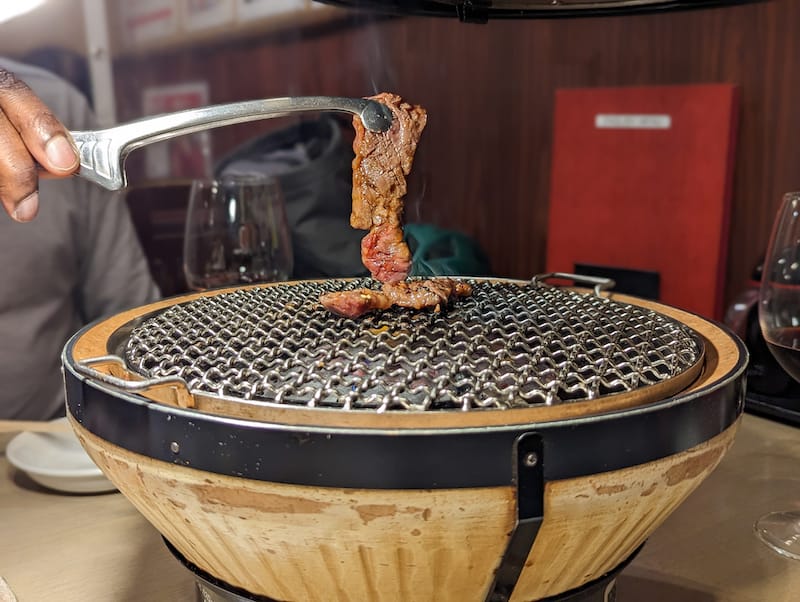
Yakitori: Hinotori
West Shinjuku might seem like a skyscraper desert, but there are gems tucked among its building behemoths. Hinotori is a small yakitori place which specializes in Daisendori, a quality brand of chicken produced at the foot of Mount Daisen in Japan’s southwest Tottori.
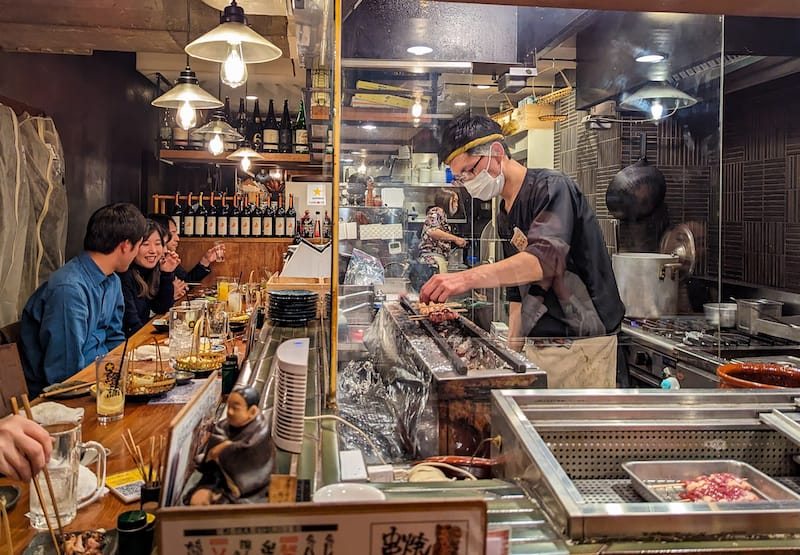
A meal begins with the otoshi (a small dish paired with alcohol) – a strong offering of crisp, fresh veggies with a frankly addictive niku-miso (mincemeat miso dip). It’s the perfect way to balance out the saltiness and fattiness of the grilled chicken to come. Hinotori offers a wide range of chicken parts grilled over charcoal. The adventurous or simply indecisive diner can order five sticks omakase, leaving the choices up to the staff. Make sure to add crispy, juicy chicken wings to the mix along with the fantastic tsukune tsukimi, a long chicken meatball on a stick that arrives with a raw egg yolk to add extra umami. There are skewered veggies too, including ever-popular asparagus and shiitake, and it’s worth tucking into a pleasingly curry-spiked potato salad, topped with a soft-boiled egg.
Be warned that seats at the counter near the grill can be a little smoky, leaving several diners teary-eyed, but there are seats further back and a few tables.
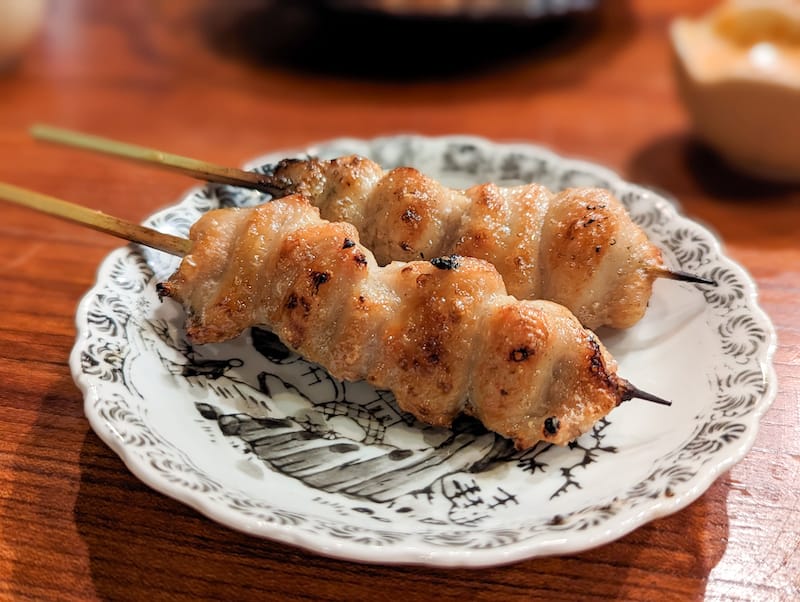
 October 13, 2017 Harvest Week
October 13, 2017 Harvest Week
Saffron may be most commonly associated with Iran, currently the world’s largest […] Posted in Barcelona November 26, 2021 Building Blocks
November 26, 2021 Building Blocks
At first glance, quince can often pass as a larger version of its cousin the pear. But […] Posted in Athens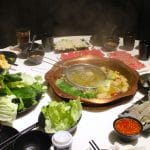 December 30, 2014 Holy Cow
December 30, 2014 Holy Cow
Editor's note: Soup Week at Culinary Backstreets heats up with our second installment in […] Posted in Shanghai
Published on December 15, 2023
Related stories
October 13, 2017
BarcelonaSaffron may be most commonly associated with Iran, currently the world’s largest producer of this costliest of spices, but it has a long and storied history across the Mediterranean, particularly in Spain. Once an important saffron producer and trading center, Catalonia has seen a resurgence in saffron cultivation in recent years. The spice, which comes…
November 26, 2021
AthensAt first glance, quince can often pass as a larger version of its cousin the pear. But it becomes a bright golden yellow as it matures – hence, it’s longstanding nickname, “the golden apple.” When the quince made its way west from south Asia and the Caucasus into Ancient Greece, the fruit quickly took to…
December 30, 2014
ShanghaiEditor's note: Soup Week at Culinary Backstreets heats up with our second installment in the series, in which our Shanghai correspondent reports on a new hotpot specialist in Xuhui that takes extraordinary care in how it sources ingredients. We’d just about given up on hotpot, what with last year’s scandals of rat meat parading as lamb…







































